ISSN ONLINE(2319-8753)PRINT(2347-6710)
ISSN ONLINE(2319-8753)PRINT(2347-6710)
Sudheer Reddy .L1 , Ramana Rao. N.V2 , Gunneswara Rao, T.D3
|
| Related article at Pubmed, Scholar Google |
Visit for more related articles at International Journal of Innovative Research in Science, Engineering and Technology
In the recent past the use of steel fibers to improve the mechanical properties of concrete has been the prime research area in structural applications. The paper makes an attempt to study the improvement of shear strength of high strength concrete beams (65 MPa) with different shear span to depth ratios (a/d = 1, 2, 3, and 4) and various dosages of fibers (0.4%, 0.8%, and 1.2% by volume of concrete) only in shear predominant regions, without shear reinforcement. The experimental studies were validated analytically by modeling the beams in ANSYS. The investigations revealed an increase in shear capacity with addition of fiber at different shear span to depth ratios (a/d) ratios. Further the test results of the beams with fiber only in critical regions indicated almost the shear capacity similar to that of the beams reinforced with fiber throughout, thus usage of fiber in shear critical regions shall be more cost effective.
Keywords |
| High-strength Concrete, Shear, Steel fiber reinforced concrete, Shear span to Depth Ratio (a/d). |
INTRODUCTION |
| Concrete is known for its good compressive strength and low tensile strength. Researchers are continuously striving to improve its tensile capacity, as it is being the most accepted composite used for all structural applications. In this course, usage of steel fiber reinforced concrete (SFRC) emerged and many studies having been undertaken over the past four decades. Numerous researchâÃâ¬ÃŸs (e.g. Narayanan. R et al.,[1]; Kwak et al.,[2] ) has been conducted on the shear behavior of FRC over the past decades and the general conclusion is that, with proper mixture design FRC is capable of considerably increasing performance in terms of shear strength and ductility when compared to plain concrete. From most of the reviews, it may be concluded that Steel Fiber Reinforced Concrete (SFRC) is a composite material with significantly better tensile strength and higher resistant to crack formation and propagation. Research on the high strength concrete showed that the cube compressive strength has less significance than the fracture energy for the description of the material behavior of structural elements. |
| Researchers such as, Imam.M. et al[3] and Bukhari.I.A et al[4], reported that high strength SFRC beams possess higher shear capacity than the non fibrous beams. All the research works emphasized the usage of fibers throughout the elements for their study. As the addition of fibers makes the conventional concrete costlier, its usage can be restricted to stress concentrated regions. Research studies with this aspect are almost less. In this paper, shear behavior of high strength concrete beams without web reinforcement, varying shear span to depth ratio and volume fraction of fibers (throughout the beam and only in critical regions) is presented. The experimental studies were validated analytically using ANSYS. |
OBJECTIVES OF THE STUDY |
| To assess the response of high strength concrete (HSC) beams under shear loading, the following studies were carried out both experimentally and analytically. |
| • Behavior of steel fibrous concrete beams without shear reinforcement, with a/d ratio from one to four and with volume fractions of fiber as 0.4%, 0.8%, and 1.2% of volume of concrete throughout the beam termed as High Strength Fiber reinforced concrete (HSFRC) - (FR series). |
| • Behavior of steel fibrous concrete beams without shear reinforcement, with a/d ratio from one to four and with volume fractions of fiber as 0.4%, 0.8%, and 1.2% of volume of concrete only in critical regions of the beam (CFR series). |
EXPERIMENTAL PROGRAMME |
| The experiments were carried out in two phases by casting and testing the beams in laboratory. |
| • The first phase involved casting and testing of twelve fibrous HSC beams without shear reinforcement with a/d equal to one, two, three, and four and fiber content of 0.4%, 0.8%, and 1.2% of volume of concrete-FR series. |
| • The second phase involved casting and testing of twelve fibrous HSC beams without shear reinforcement with a/d equal to one, two, three, and four and fiber content of 0.4%, 0.8%, and 1.2% of volume of concrete only in critical regions- CFR series. |
| For ensuring the SFRC in critical regions, two stoppers were placed at critical positions. After the first layer of concrete is laid for 50mm the stoppers were removed and concrete was compacted using needle vibrator. Again stoppers were put at the same position and the next layer of concrete was laid. After the second layer was complete, again the stoppers were removed and the concrete is compacted. The same procedure was followed for rest of the beam. In the experimental programme, the parameters viz., designed concrete proportions, aspect ratio of fibers and percentage of longitudinal reinforcement were kept constant. The details are listed in table I and II: |
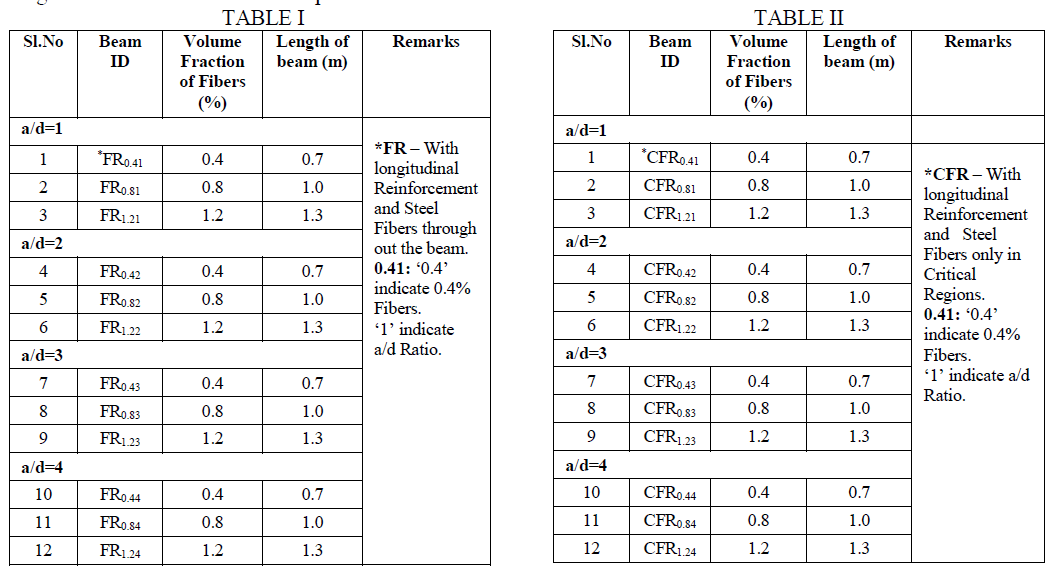 |
| Materials Used |
| The ingredient materials physical and mechanical properties used for casting HSFRC beams such as cement, fine aggregate, coarse aggregate and longitudinal reinforcement are taken as per IS code provisions. The type and shape of the steel fibers used for casting was straight and rounded with aspect ratio (l/d) of 75. To improve the workability of fibrous concrete naphthalene based super plasticizer Conplast337 was utilized. Natural pozzolonas such as, fly ash (Class F) acquired from Kothagudam thermal power station and Ground Granulated Blast Furnace Slag (GGBS) with physical requirements confirming to IS 12089 1987 [5] procured from Vizag were utilized. |
| Mix Design |
| The mix design for high strength concrete has been evaluated using Erntroy H.C. et al [6]. Trial mixes were conducted to achieve the final mix proportions, which are listed in table III. The 28-day compressive strength arrived with the proportion below was 65MPa. |
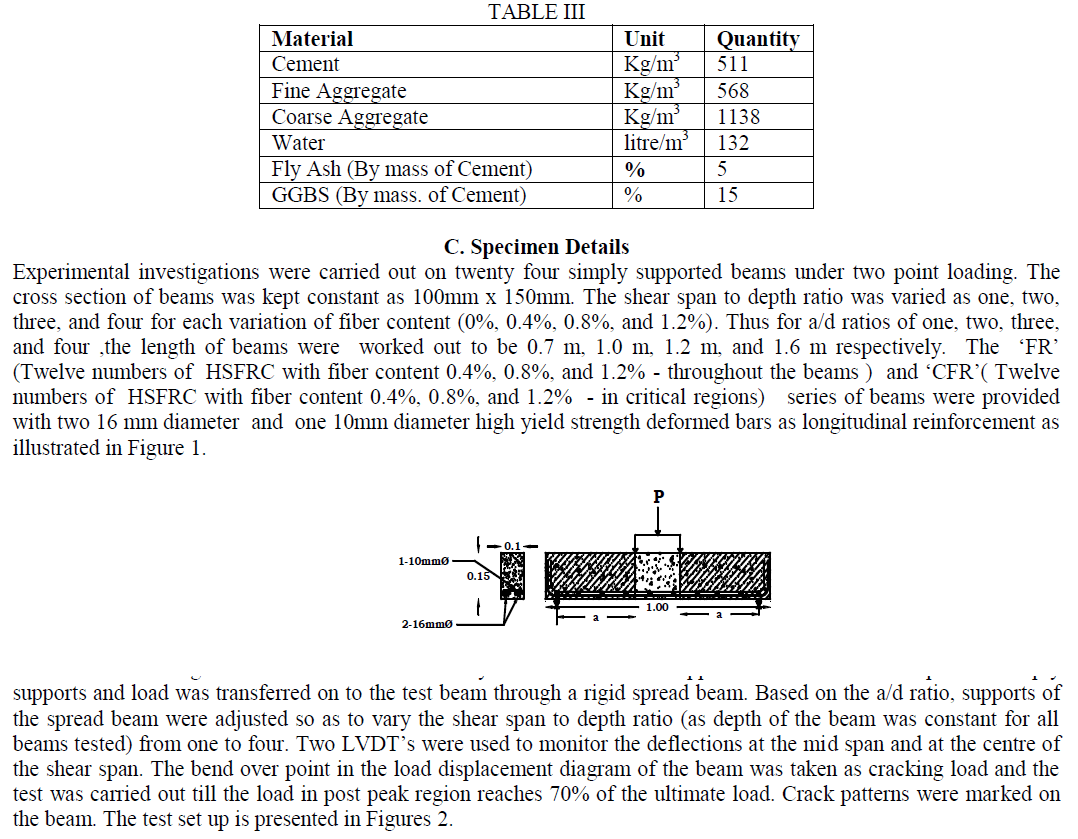 |
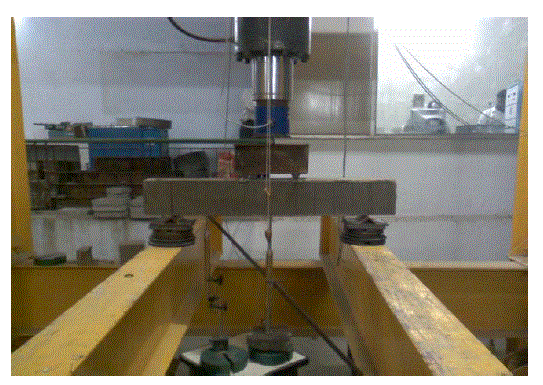 |
| Fig 2: 100 ton loading frame - Arrangement of test specimen |
ANALYTICAL PROGRAMME |
| Finite element method (FEM) models were developed to simulate the behavior of HSC beams from linear through nonlinear response and up to failure, using the ANSYS program. ANSYS is a general purpose finite element modeling package used for analyzing static/dynamic structural analysis (both linear and non-linear), heat transfer and fluid problems, as well as acoustic and electro-magnetic problems. In this context the all the beams are modeled in ANSYS as per their physical condition desired to satisfy the research studies. |
| The analytical programme was carried out in three phases by modeling the beams in ANSYS similar to experimental programme. |
| • Phase -I: Modeling of twelve HSC beams without shear reinforcement with a/d equal to one, two, three, and four varying fiber content as 0.4%, 0.8%, and 1.2% of volume of concrete. |
| • Phase II: Modeling of twelve HSC beams without shear reinforcement with a/d equal to one, two, three, and four and varying fiber content only in critical regions as 0.4%, 0.8%, and 1.2% of volume of concrete. |
| A. Modeling of Concrete and Reinforcement in ANSYS: |
| „SOLID65âÃâ¬ÃŸ an eight noded brick element capable of simulating the cracking and crushing has been used for modeling concrete. The compressive strength and tensile strength are established based on test data of the specimens cast and tested along with the rectangular beams. The concrete youngâÃâ¬ÃŸs modulus is obtained from the stress-strain behavior of the concerned composite and the PoissonâÃâ¬ÃŸs ratio is taken as 0.2. The constant mesh size of 25mm is assumed. The meshed solid is presented in figure 3. The compressive strength of concrete was taken as 65Mpa. The compressive uniaxial stress-strain relationship obtained from Hognestad. A et al [7] was used for „RâÃâ¬ÃŸ series beams. The equation proposed by Luiz Álvaro de Oliveira Júnior[8] is adopted to compute the multi-linear isotropic stress-strain for SFRC, which was an input for analysis of FR and CFR beams in ANSYS. For plain concrete, the coefficient for the open crack (βt) was set to 0.25 and the coefficient for closed crack (βc) was set to 0.7. For fiber reinforced concrete, based on the studies of Job Thomas et al [9], βt was set to a value of 0.3, 0.35 and 0.40 and βc as 0.7, 0.73, 0.76 and 0.80 for fiber reinforced concrete Vf = 0.4%,0.8% and 1.2% respectively. |
| LINK8 3D Spar element was used for modeling the longitudinal reinforcement i.e. the High Yield Strength Deformed (HYSD) bars. The reinforcement was modeled corresponding to experimental studies. The cross sectional area of each element is taken as area equivalent to each rebar. The rebar youngâÃâ¬ÃŸs modulus is taken as 2 x 105 MPa and PoissonâÃâ¬ÃŸs ratio as 0.3. The mesh size for rebar is taken same as that of concrete element. Perfect bond between concrete and reinforcement is ensured between the two elements in ANSYS. The figure 3 shows a typical beam modeled in ANSYS for a/d =1 with element mesh size of 25mm. |
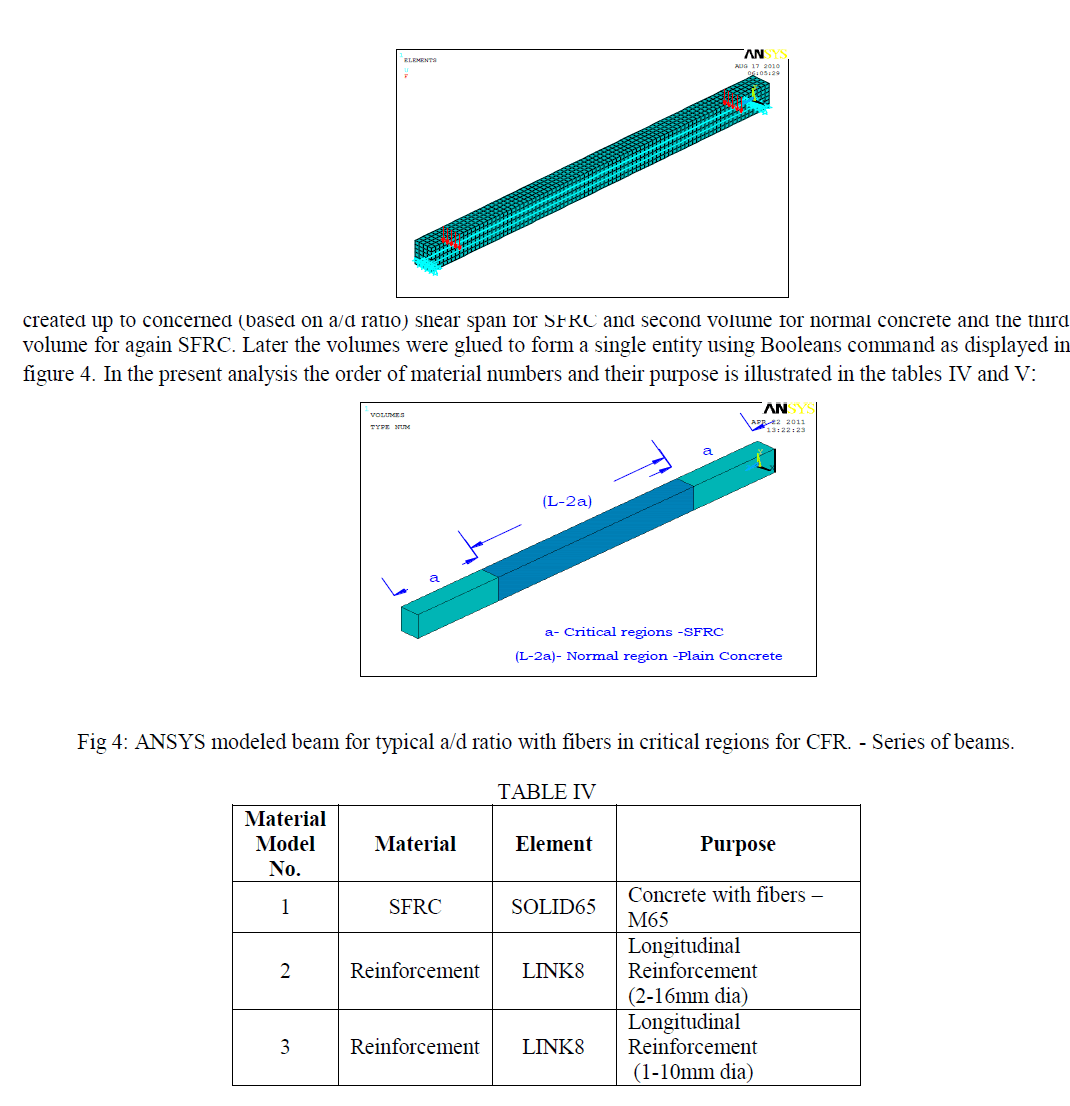 |
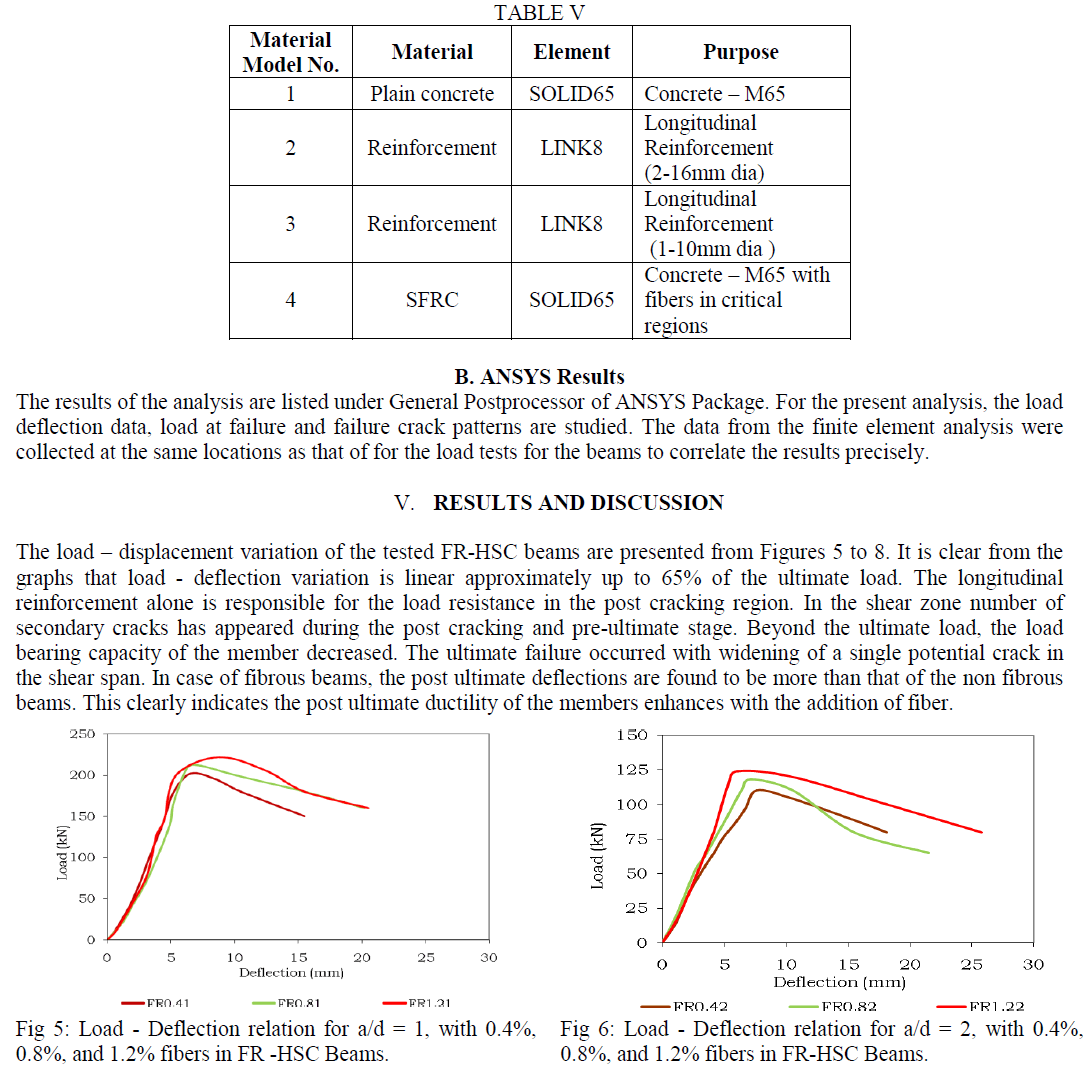 |
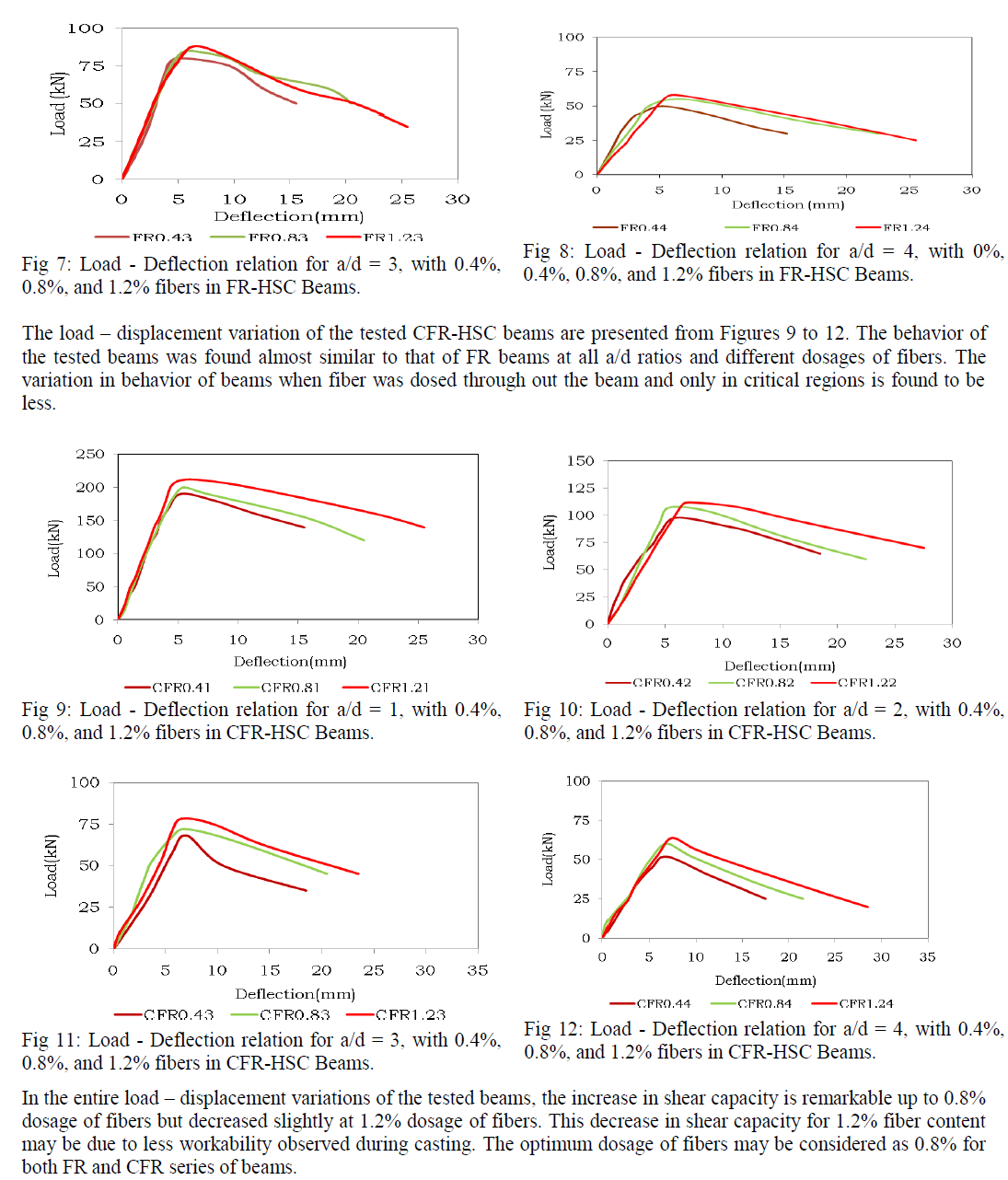 |
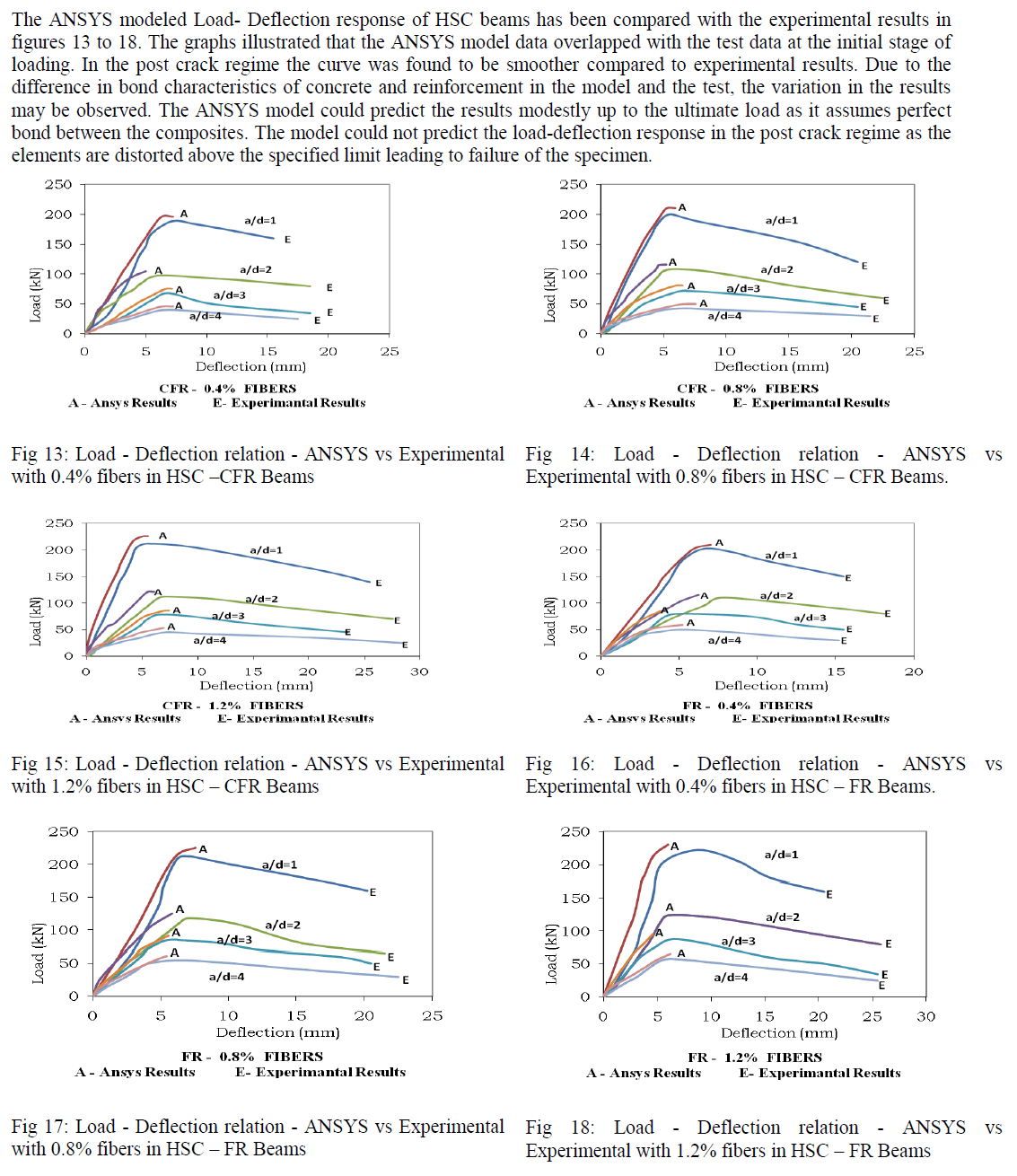 |
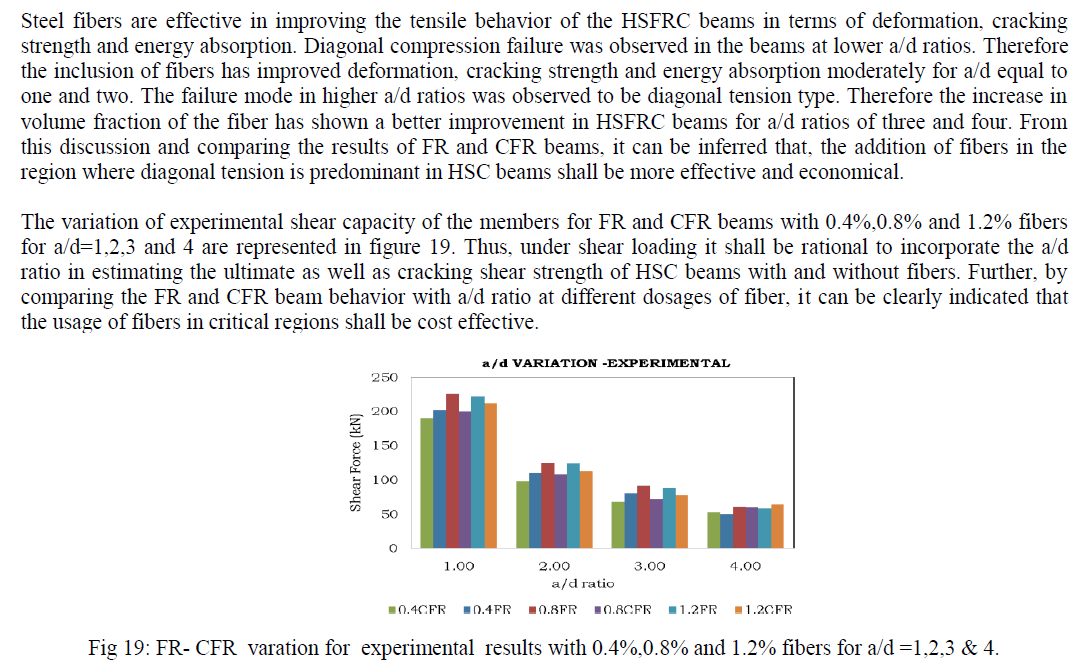 |
CONCLUSION |
| Based on the analytical and experimental studies conducted on HSC, HSFRC (with fiber throughout the beam and only in critical regions) beams without web reinforcement under shear loading, the following conclusions have been drawn: |
| • The influence of fiber influence on both first and ultimate crack loads for HSFRC beams is substantial at lower a/d ratios, i.e. at a/d less than two. |
| • The influence of fiber on shear capacity of HSFRC beams is less at higher a/d ratios. |
| • The energy absorption capacity of HSFRC elements at all a/d ratios is high when compared with conventional non fibrous concrete beams. |
| • The analytical and experimental results revealed that for all a/d ratios, for 0.8% volume fraction of fibers there is a maximum increase in shear capacity of beams. |
| • As the analytical and experimental results are almost similar, it shall be rational to incorporate the a/d ratio in estimating the ultimate as well as cracking shear strength of HSC beams with and without fibers under shear loading. |
| • The improvement of the shear capacity of the beams with fiber throughout the beam and fiber in critical regions was found to be almost similar. |
| • Thus the usage of fiber in shear critical regions shall be more cost effective. |
References |
|